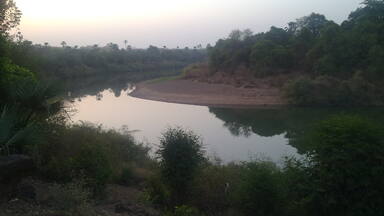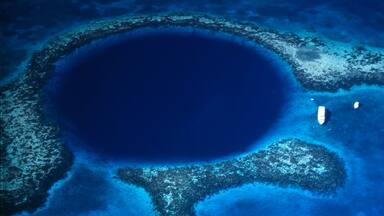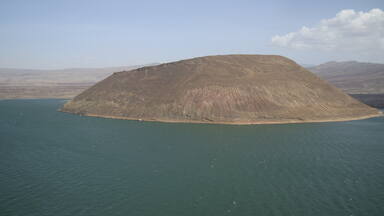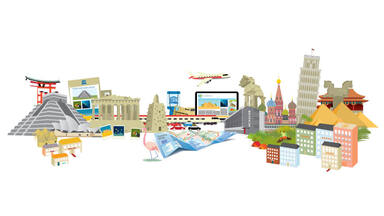Cultural and natural heritage is not only an irreplaceable source of identity and inspiration, but also a key driving force for sustainable development
The 2030 Agenda for Sustainable Development marks a substantial step forward for sustainable development in many fields, and particularly for heritage as it is the first time that the international development agenda refers to culture within the framework of Sustainable Development Goals related to education, sustainable cities, food security, the environment, economic growth, sustainable consumption and production patterns, peaceful and inclusive societies.
The recently adopted Policy on the integration of a sustainable development perspective into the processes of the Convention (adopted by the World Heritage General Assembly in 2015) provides an opportunity to better understand and assess the socio-economic impact of World Heritage. The Policy aims at assisting States Parties, practitioners, institutions, communities and networks to harness the potential of World Heritage properties and heritage in general, to contribute to sustainable development. English
The UNESCO World Heritage Centre has worked for a number of years on issues related to economic impacts of World Heritage listing. It has commissioned studies and participated in conferences and workshops to explore the interaction between economics and natural and cultural heritage. In parallel, a number of studies were carried out by researchers, universities and interested stakeholders investigating the correlation between the World Heritage listing and economic development.
Research has shown that World Heritage status can have a major socio-economic impact. For instance, in a recent report published in 2015, the UK National Commission for UNESCO finds that UNESCO projects in Scotland generated an estimated £10.8 million from April 2014 to March 2015 through their association with UNESCO (http://www.unesco.org.uk/wp-content/uploads/2016/11/UNESCO-in-Scotland_Brochure_Low-Resolution-Version.pdf)
However, directly attributing socio-economic impacts to the UNESCO World Heritage designation is complex. It has been demonstrated that it is rarely the designation itself which achieves the impacts, but particularly the actions and investments of the local stakeholders.
Socio-economic impacts of Tourism
Tourism has the potential to contribute, directly or indirectly, to all of the Sustainable Development Goals. In particular, it has been included as a target in Goals 8, 12 and 14 on inclusive and sustainable economic growth, sustainable consumption and production (SCP) and the sustainable use of oceans and marine resources, respectively.
Tourism can provide direct jobs to the community, such as tour guides or in the hospitality industry (hotels, bars and restaurants). Indirect employment is generated through other industries such as agriculture, food production, creative industries (art, music performance) and retail (souvenirs).
As well as providing jobs, the additional investment and spending brought by tourism can support a wide variety of services including water and energy distribution, roads and transport services, health services, shops, garages, leisure and entertainment facilities, and outdoor amenities.
Infrastructure development such as airports, roads, schools, hospitals, and retail areas have the potential to benefit the local community and can aid economic development by allowing more trade and better flow of goods and services.
By showcasing distinct characteristics of their ways of life, history and culture, tourism can produce a sense of pride and identity to communities.
Tourism can provide financial support for the conservation of World Heritage making the destination more authentic and desirable to visitors and adding value to the local tourism business.
As such, tourism has a direct effect on the socio-economic impact on World Heritage properties. However, the availability of reliable and comparable data on the economic impact of tourism on a global level is significantly lacking.
To date no globally standardized data is available on visitor numbers and/or economic impacts. It has led to “patchwork monitoring” which does not allow for global comparison, reporting or benchmarking.
Pointing to a need to develop indicators to assess the impact of tourism at World Heritage properties, the UNESCO World Heritage and Sustainable Tourism Programme is working with University of Würzburg (Germany), Griffith University (Australia), Tourism and Protected Areas Specialist Group (TAPAS Group) of the IUCN World Commission on Protected Areas (WCPA), and the German Federal Agency of Nature Conservation (BfN) to initiate a process of harmonization and standardization of methodologies for the evaluation of visitation (including visitor spending and regional economic effects) to UNESCO natural World Heritage sites.
Negative Socio-economic Impacts
There are some types of development – large-scale infrastructure such as mining, dams, roads and railways, urban development, and development of tourist facilities – that can cause significant negative impacts to the Outstanding Universal Value of the World Heritage properties.
According to IUCN, one of the most likely threats to affect natural World Heritage sites is energy production (including oil and gas) and mining. This illustrates the challenge of balancing economic development with the conservation.
In the case of extractive industries, the World Heritage Committee has adopted a clear position that oil and gas, minerals, and metals exploration or exploitation are incompatible with World Heritage status. https://whc.unesco.org/en/decisions/6817/
Recognizing this, a number of industry leaders, such as the International Council on Mining and Metals (ICMM), Royal Dutch Shell and Total, Tullow Oil plc and CEMEX have committed to not carrying out activities in World Heritage sites. However, much more needs to be done in terms of prohibiting mining and other resource extraction activities in the World Heritage sites.
Select Bibliography
In an effort to gain insight into the socio-economic impacts of World Heritage listing, an inventory of relevant publications has been compiled.
Aa, van, B.: Preserving the heritage of humanity? Obtaining world heritage status and the impacts of listing. University of Groningen. 2005.
http://dissertations.ub.rug.nl/faculties/rw/2005/b.j.m.van.der.aa/
Anderson, S.: World Heritage in cities: a possibility for change and development - effects on the economy. In: Preservation and World Heritage Cities: integration by rehabilitation. pp. 30-31. City of Bamberg. Bamberg. 2004.
Angelini, A.: Quanto vale il brand UNESCO ? Retrieved October 2013 from www.educqzionesostenibile.it
http://www.educazionesostenibile.it/portale/sostenibilita/patrimoni-dellumanita/1562-quanto-vale-il-brand-unesco.html
Arezki, R. et al.: Tourism Specialization and Economic Development: Evidence from the UNESCO World Heritage List. International Monetary Fund Working Paper 09/176. 2009.
http://books.google.fr/books?id=UIntUFVExI8C&printsec=frontcover&hl=it&source=gbs_ge_summary_r&cad=0#v=onepage&q&f=falsee
Australian Government – Department of the Environment (ed.): The Economics of Heritage: Integrating Costs and Benefits into Government Decision-Making. 2007. http://www.environment.gov.au/system/files/resources/da10a766-2ef7-4989-b202-edac0f5d6f3e/files/economics-background.pdf
Bertacchini, E. et al.: Cultural Commons - A New Perspective on the Production and Evolution of Cultures. Northhampton. 2012. http://www.elgaronline.com/view/9781781000052.00025.xml
Bertacchini E. et al.: A Political Economy Analysis of World Heritage Listing. Torino. 2009.
Buckley, R. (ed.): The Effects of World Heritage Listing on Tourism to Australian National Parks. In: Journal of Sustainable Tourism, Volume 12, Issue 1 (2004), pp. 70-84. http://www.tandfonline.com/doi/abs/10.1080/09669580408667225
Cellini, R.: Is UNESCO recognition effective in fostering tourism? A comment on Yang, Lin and Han. In: Tourism Management, Volume 32, Issue 2 (2011), pp. 452–454.
http://www.sciencedirect.com/science/article/pii/S0261517710000191
Cuccia, T., Guccio, C., and Rizzo, I.: The effects of UNESCO World Heritage List inscription on tourism destinations performance in Italian regions. In: Economic modelling, Volume 53 (2016), pp. 494-508.
Cummings, R. et al.: Valuing Environmental Goods: An Assessment of the Contingent Valuation Method. Totowa, New Jersey. 1986.
Dalberg Global Advisers: The Economic Value of Virunga National Park World Heritage Area. Report on behalf of World Wide Fund for Nature (WWF). Gland. 2013. http://assets.worldwildlife.org/publications/611/files/original/The_Economic_Value_of_Virunga_National_Park_LR.pdf?1375288396
Gillespie Economics and BDA Group: Economic Activity of Australia’s World Heritage Areas. Denistone. 2008.
Government of Canada, Canada’s Federal Tourism Strategy: Welcoming the World, 2011
Greffe, X.: Arts and Artists from an Economic Perspective. UNESCO, Culture, Development and Society series. 2002. https://en.dl-servi.com/
Hambrey Consulting: Social, economic and environmental benefits of World Heritage Sites, Biosphere Reserves, and Geoparks. Scottish National Heritage Commissioned Report No. 248. 2007.
http://www.snh.org.uk/pdfs/publications/commissioned_reports/Report%20No248.pdf
Hampton, Mark P.: Heritage, local communities and economic development. In: Annals of Tourism Research. Volume 32. Issue 3 (2005), pp. 735-759.
Hayward, Pippa, Clarke, Mike et al.: The Heritage Economy. In: Conservation Bulletin. Volume 64 (2010), pp.10-22. https://content.historicengland.org.uk/images-books/publications/conservation-bulletin-64/cb-64-pp10-22.pdf/
Hutter, M., Rizzo, I. (eds): Economic Perspectives on Cultural Heritage. Basingstoke. 1997.
Huanga, C. et al.: Does world heritage list really induce more tourists? Evidence from Macau. In: Tourism Management, Volume 33, Issue 6, (2012), pp. 1450–1457.
http://www.sciencedirect.com/science/article/pii/S0261517712000179
Innovation, Science and Economic Development Canada, Best Practice at World Heritage Sites: A Tourism-based comparative analysis of UNESCO World Heritage Sites in Canada, the United States and Australia, 2015
https://www.ic.gc.ca/eic/site/034.nsf/vwapj/Best-Practices-WHS-Final-v5.pdf/$file/Best-Practices-WHS-Final-v5.pdf
Johnson, P., Thomas, B.: Heritage as Business. In: David H. (ed.): Heritage, Tourism and Society. New York. 1995.
Jones, C., Munday, M.: Blaenavon and United Nations World Heritage Site Status: Is Conservation of Industrial Heritage a Road to Local Economic Development? In: Journal of Regional Studies. Volume 35, Issue 6 (2001), pp. 585-590.
Kayahan, B., Vanbalrcom, B.: Cost Benefit Analysis of UNESCO World Heritage Site, Designation in Nova Scotia. In: Review of Economic Analysis 4 (2012), pp. 247-273.
Kirshenblatt-Gimblett, Barbara: World Heritage and Cultural Economics. In: Karp, Ivan et al. (ed.): Museum Frictions. Public Cultures/ Global Tranformations. Durham. 2006, pp. 161-202.
Lia, M.: Tourism development of World Heritage Sites in China: A geographic perspective. In: Tourism Management, Volume 29, Issue 2, (2008), pp. 308–319.
Mouton, B. (ed.): Le Patrimoine moteur du développement – Enjeux et projets Résultats de la XVIIème Assemblée Generale de l’ICOMOS. Paris. 2013.
Morgan, M., Ranchhod, A. (ed.s): Marketing in Travel and Tourism. Case 3: Marketing World Heritage – the Taj Mahal, India Issue, Challenges and Opportunities. Oxford. 2009.
Mossetto, G., Vecco, M.: Economia del patrimonio monumentale. Venice. 2001.
National Park Service (US Department of the Interior), 2014 National Park Visitor Spending Effects: Economic Contribution to Local Communities, States and the Nation, 2015
Netzer, D.: International Aspects of Heritage Policies. In: Alan Peacock (ed.): Does the Past Have a Future? The Political Economy of Heritage. London. 1998.
Ost, C.: A Guide for Heritage Economics in Historic Cities – Values, Indicators, Maps, and Policies. Los Angeles Getty Conservation Institute. 2009.
PriceWaterhouseCoopers, The Costs and Benefits of World Heritage Site Status in the UK Department of Media, Culture and Sport, 2007
Prud’homme, R.: Les impacts socio-économiques de l’inscription d’un site sur la liste du patrimoine mondial: Trois études. 2008.
http://www.rprudhomme.com/resources/2008+Impact+Liste+Patrimoine.pdf
Purdy, E.: An Economic Impact Assessment of UNESCO World Heritage Designation in Eastern Canada, Acadia University. 2013.
http://openarchive.acadiau.ca/cdm/singleitem/collection/HTheses/id/829/rec/16
Rebanks Consulting Ltd. on behalf of the Lake District World Heritage Project: World Heritage Status, Is there opportunity for economic gain? Research and analysis of the socio-economic impact potential of UNESCO World Heritage Site status. 2009.
http://rebanksconsultingltd.com/resources/WHSTheEconomicGainFinalReport.pdf
Rizzo, I., Throsby, D.: Cultural Heritage: Economic Analysis and Public Policy. In: Handbook of the Economics of Arts and Culture, Volume 1, pp. 983-1016. 2006.
Ryana, C. et al.: The impacts of tourism at a UNESCO heritage site in China – a need for a meta-narrative? The case of the Kaiping Diaolou. In: Journal of Sustainable Tourism, Volume 19, Issue 6 (2011), pp. 747-765.
http://www.tandfonline.com/doi/abs/10.1080/09669582.2010.544742
Santagata, W.: Cultural Districts and Their Role in Developed and Developing Countries. In: Handbook of the Economics of Art and Culture, Volume 1 (2006), pp. 1102-1118.
Serageldin, I.: Very special places: The architecture and economics of intervening in historic cities. The World Bank. Washington. 1999. http://www-wds.worldbank.org/external/default/WDSContentServer/%20WDSP/IB/1999/09/14/000094946_9905260827175/Rendered/PDF/multi_page.pdf
Towse, R. (ed.): A Handbook of Cultural Economics. Northhampton. 2011.
UK National Commission for UNESCO: Wider Value of UNESCO in UK UNESCO in Scotland. 2016.
http://www.unesco.org.uk/wp-content/uploads/2016/11/UNESCO-in-Scotland_Brochure_Low-Resolution-Version.pdf?platform=hootsuite
UK National Commission for UNESCO: Wider Value of UNESCO in UK, Contribution of UNESCO to the work of UK organisations. 2015.
http://www.unesco.org.uk/wp-content/uploads/2016/02/UK-National-Commission-for-UNESCO_Wider-Value-of-UNESCO-to-the-UK_UK-Organisations_January-2016.pdf
United Nations Conference on Trade and Development: Creative Economy Report. 2008.
http://unctad.org/fr/Docs/ditc20082cer_en.pdf
Vanblarcoma, B., Kayahana, C.: Assessing the economic impact of a UNESCO World Heritage designation. In: Journal of Heritage Tourism, Volume 6, Issue 2 (2011), pp. 143-164. http://www.tandfonline.com/doi/abs/10.1080/1743873X.2011.561858
Watson, Susan: Valuing World Heritage. North Mankato. 2004.
Yang, C.: Analysis of international tourist arrivals in China: The role of World Heritage Sites. In: Tourism Management, Volume 31, Issue 6, (2010), pp. 827–837.
http://www.sciencedirect.com/science/article/pii/S0261517709001654
Add also links to relevant WH Reviews:
https://whc.unesco.org/en/review/65/
https://whc.unesco.org/en/review/67/
https://whc.unesco.org/en/review/71/
World Heritage: Benefits Beyond Borders:
https://whc.unesco.org/en/benefits-beyond-borders/







